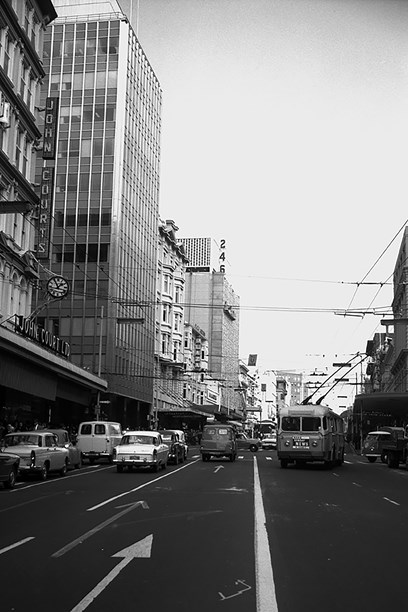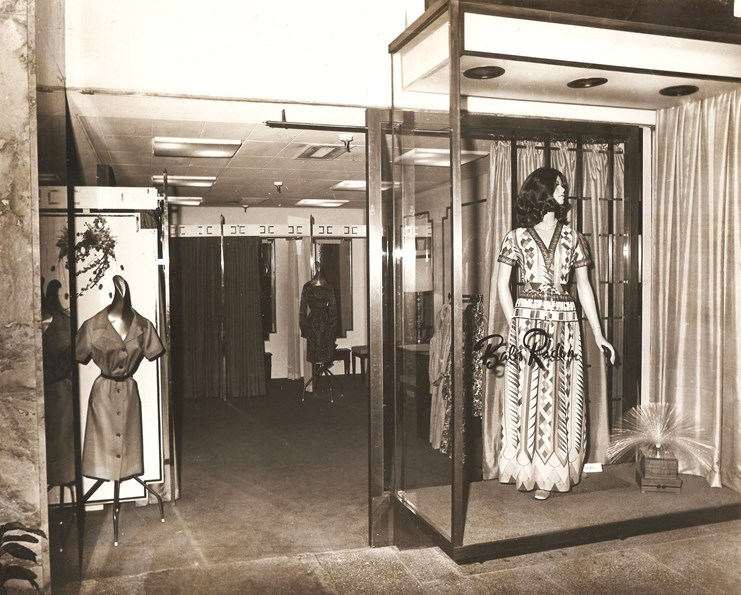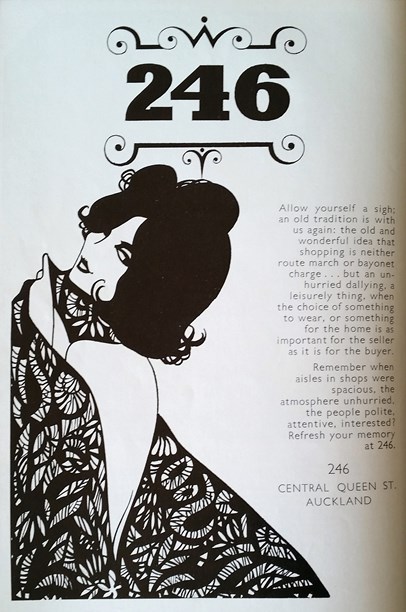Stories
246 Shopping Centre
1964-

Fashion retail in early 1960s New Zealand was dominated by department stores and exclusive salons, but the emerging youth culture meant that they soon faced competition from a growing swathe of hip young boutiques such as The Casual Shop and Elle.
Some of the department stores responded by introducing junior ranges with their own in store department, such as Milne & Choyce’s 'Miss Department', which opened in 1958. The salon owners took a different approach. They joined together to create exclusive shopping precincts such as Vulcan Lane in Auckland’s CBD, home to Tarantella, Flair and John Greer’s shoes. While Tarantella’s owner Joan Talbot promoted Vulcan Lane as 'Auckland’s Petite Paris' and successfully lobbied council to pedestrianise the street, a new development further up Queen Street was focused on 'Fifth Avenue' style shopping.
Established by entrepreneurial businessman and cinema owner Robert Kerridge, the 246 Shopping Centre in Queen Street, Auckland, was a new concept in New Zealand. It was a sophisticated, multi-storey mall that provided an exclusive venue to shop, dine, watch fashion shows and enjoy beauty treatments.

Looking up Queen Street, showing premises of John Court Limited, AMP building, Hallenstein Brothers building, Plaza theatre and the new 246 shopping centre, 1964. Sir George Grey Special Collections, Auckland Libraries, 7-A918. No known copyright restrictions.
This sleek and stylish building opened in July 1964 with prestigious tenants including El Jay, Iris Currie (who sold Emma Knuckey designs), Vance Vivian Menswear, Barker & Pollock, Maitland Knitwear, Scandinavian furniture store Danske Møbler and on the top floor, the Gold Room restaurant. Designed by architects Rigby Mullan, the glamorous development was eight stories high, with gleaming central escalators that gave access to the retail spaces and offices on the upper floors.
The official opening was a week-long event with fashion parades held on the top floor. Organised by fashion promoter Paddy Walker, the parades showcased the upcoming summer fashion from the retailers in 246. Maysie Bestall-Cohen was one of the models in the shows. "All the top girls of the time were featured and I was pretty much the new girl on the block." Maysie recalls modelling regularly at 246, including some special event shows on the mezzanine level to catch the Saturday night theatre crowds cutting through from Lorne to Queen Street.
Designer Bruce Papas moved into 246 in 1965. The former Milne & Choyce designer opened his own business Bruce Papas Salon - on the 2nd floor. Many of his clients followed, keeping him and his staff of five extremely busy designing one-off gowns and formalwear. The salon was decorated in white with a marble table, mirrors and gilded chairs. Only one garment was ever on display, the rest were kept out of sight in mirrored cabinets. This exclusivity was occasionally interrupted on a Friday night by groups of young people who, to the horror of Bruce and his staff, would sit down at the marble table and proceed to eat wrapped fish 'n' chips.
The 246 building made an impression on teen model Judith Baragwanath. "We got our kicks parading up and down the main drag every Friday night during the 60s and 70s," she says. "In those days the street was alive with late night shoppers, tearaways, runaways, show-offs, hot rodders, bikie gangs (for a bit of rough) and cops on the beat. We’d rendezvous outside 246, which was, at the time, Auckland’s tallest building. A skyscraper no less! There were always protest marches and if we felt so inclined we’d jump in and join the noisy fray."
Not far from Bruce Papas, on the second floor, was El Jay which sold the exclusive Christian Dior Boutique Collection. El Jay also had a small shop on the ground floor that sold firstly hats (El Jay Chapeaux), then knitwear. When El Jay introduced their Ultrasuede line in the late 1970s, the ground floor store was redeveloped for this new range.

The Babs Radon salon in the 246 shopping centre.
By 1967, the original tenants had been joined by Babs Radon, Yum Yum Originals, Johnston Furs and Anne Seagar. Despite the glamorous facade, many retailers on the upper floors of 246 found that they received very little foot traffic.

Magazine ad for 246, 1967.
Barbara Herrick had opened her Babs Radon retail outlet on the 4th floor, but she quickly realised that it was crucial to be closer to street level and moved to a lower floor. This move only went part of the way to solving the problem and by the 1970s, the smart tailoring that defined designers such as Barbara Herrick was giving way to a more casual style and she retired her label.

Michal Walker McKay modelling a wedding dress by Babs Radon in a show held at 246 in February 1968. Image © Barbara Herrick.
Early in the 1980s El Jay closed their upper level salon, focusing instead on the ground floor Ultrasuede shop. Bruce Papas also left 246 after a stroke prompted him to close his business to focus on recuperation. A decade later, and most of the fashion retailers had left 246, and attention was instead centred around the boutiques of Vulcan Lane and the High Street District.
Text by Kelly Dix. Banner image © Barry McKay Industrial Photography.
Last published September 2017.